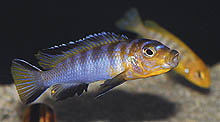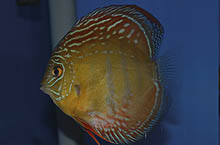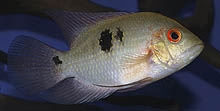WHAT'S NEW ACROSS THE WORLD
Select date in side bar to go a What's
New of previous issues
| What's New ©by
Laif DeMason
Evidence of the recent downswing in the economy
can be found in many areas of the world. With large price increases in
fuel, consumer items become more and more expensive. Generally speaking,
in bad economic times, the aquarium industry does a bit better as people
tend to travel less and stay home more. However, nowadays, there are many
more electronic devices, from computers to game systems, people can enjoy
at home, and perhaps aquarium fish will still suffer. Hobbyists in a large
metropolitan area may have a good cichlid store to rely on for their choice
selections, however many hobbyists can only purchase new cichlids through
large national or international shows or the internet. If you are one of
the lucky cichlid hobbyists who do have a local retail outlet with good
fish, support that store with your visits and purchases. Hopefully, these
stores will thus remain viable in tough times as well.
Here’s “what’s new” on the cichlid scene: |
Lake Tanganyika
Collections and stocks have recently been shrinking from several suppliers
on Lake Tanganyika. Some of the long time exporters seem to have lost interest
in the work and remain mostly inactive now. Many of the most popular bred
items are still available from specialized breeders and consolidators.
Importers are demanding only the ‘hard to get’ items for their customers,
knowing that these fishes will always sell.
|
what's new: Lake Tanganyika
|

Infrequently collected north of Moliro, Congo and
exported from Zambia, Tropheus moorii Kiku has a bright red patch
in the throat area. |

Reportedly from the Congo coast, Cyprichromis microlepidotus
Kassei sports pleasant hues and is irregularly available as wild imports. |

Also originally found north of Moliro, Congo, Xenotilapia
papillio Tembwe is a small, delicate fish, now generally available
through breeders. |

Collected in Moba, Congo, Cyprichromis leptosoma
saddleback is a boldly colored morph. Individual fish from this place
can vary within the population with different colors of blue and yellow. |
Lake Malawi
Wild-caught material is available in reasonable quantities from most
parts of Tanzania and Malawi. Interest from importers seemed to have waned
however, due to large on-hand stocks purchased from local breeders. These
breeders obtained their breeding stock during the flood of imports over
the last few years. Reportedly in Europe, many hobbyists are satisfied
with these less expensive bred fish, and buy them directly from the local
breeders when possible.

Lethrinops species are not only often confusing,
but they are becoming more popular in Europe and elsewhere. Here Tramitichromis
lituris Mdoka displays bold fin coloration and is often collected south
of Itungi Port, Tanzania. |

An oddity collected from Makonde, Tanzania, and infrequently
available, Pseudotropheus benetos is an interesting cichlid. This
fish can be aggressive, even for the most experienced mbuna hobbyist! |

A rare find and only generally available from breeders,
Mylochromis plagiotaenia originally hails from the southern end
of the lake. |

Regularly available in the 1970s from Cape Maclear,
Malawi, Tropheops microstoma is a boldly-colored sand mbuna that
has been recently exported again. |

A member of the elongatus group of mbuna, Pseudotropheus
cyaneus is from Chinyamwezi Island, Malawi. Its small size and bright
yellow-orange head make it a nice addition for those who can obtain these
cichlids. |

Bred in Germany from a selected mix of Malawi species,
Aulonocara ‘Firefish’ is popular because of the bright orange-red
coloration. This fish seems to be a continuation of the new designer strains
of the popular Malawi peacocks. |
Lake Victoria
There is no more news about wild collections from anywhere in the Victorian
basin countries. Citing difficulties in logistics and sales, collectors
have now stopped their recent efforts. However, several interesting items
are still available, especially from the countries where hobbyists have
taken an interest in these Victorian cichlids.
|
what's new: Lake Victoria
|

Only available from specialized breeders, Pundamilia
red head nyererei can sport strong red and green coloration and is still
infrequently seen for sale. |

Another cichlid bred primarily in Europe, ‘Haplochromis’
red back scraper can be found occasionally available from wholesalers there. |
West Africa
Cichlids supplies continue to dribble in from the exporting countries
in West Africa. Several collectors and exporters are finding it hard to
keep prices low as most all items needed to run their businesses continue
to increase at alarming rates. It seems that these exporters may eventually
be forced to increase their fish prices.

Collected from Lake Barombi-Mbo, Cameroon, Myaka
myaka is infrequently exported. The boldly contrasting black and white
markings, along with its active behavior, make this fish an interesting
addition. |

Sometimes found incidentally mixed in bags of fishes
imported from Cameroon, this cichlid may be Parananochromis caudifasciatus. |
Neotropics
Cichlids from the tropical parts of the new world come from many sources.
Several importers carry most items from the exporting countries, whereas
there are also a few who just import specialty cichlids like discus.
There are also many breeders in many places in the world who produce large
numbers of several popular species. Other breeders only produce selective
cichlid types, some of which were originally collected by these breeders.

Collected from Alenquer area in Brazil, Symphysodon
discus Curipera is a red brown variety with strong red hues. Often
these wild discus are only available from specialty dealers. |

Hypselecara temporalis or the chocolate cichlid,
is one of many neotropical species that is commercially bred in large numbers
for fish stores sales. Note the distinctive red eye ring. |
Select date in side bar to go a What's
New of previous issues
|















